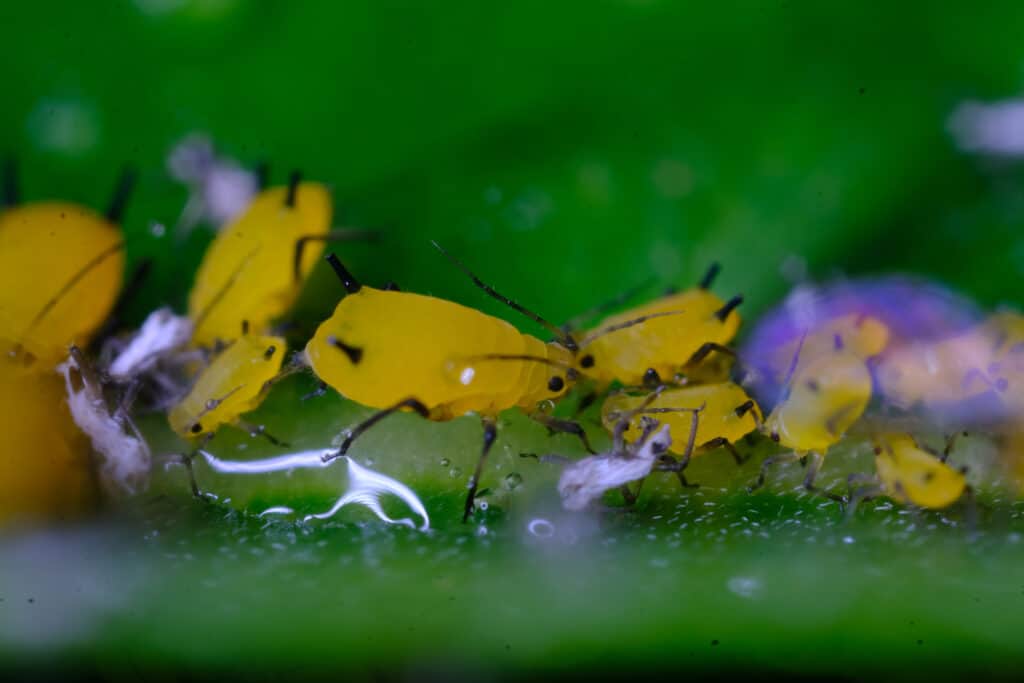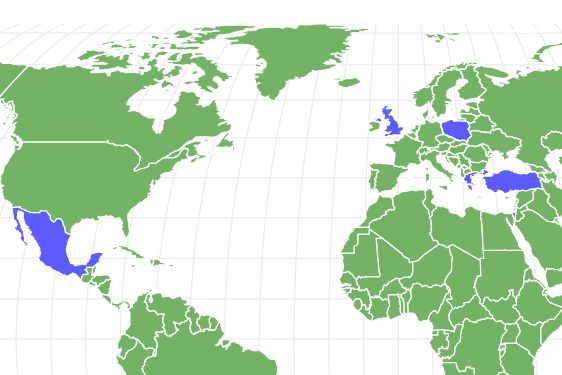Yellow Aphids
Aphis nerii
These aphids are primarily wingless; however, once the infestation on their host gets too crowded, they develop wings, allowing them to fly to a new host plant.
Advertisement
Yellow Aphids Scientific Classification
- Kingdom
- Animalia
- Phylum
- Arthropoda
- Class
- Insecta
- Order
- Hemiptera
- Family
- Aphididae
- Genus
- Aphis
- Scientific Name
- Aphis nerii
Read our Complete Guide to Classification of Animals.
Yellow Aphids Conservation Status
Yellow Aphids Facts
- Name Of Young
- Nymphs
- Group Behavior
- Infestation
- Fun Fact
- These aphids are primarily wingless; however, once the infestation on their host gets too crowded, they develop wings, allowing them to fly to a new host plant.
- Biggest Threat
- Humans
- Most Distinctive Feature
- Bright yellow coloring
- Other Name(s)
- Oleander Aphids
- Habitat
- Oleander or Milkweed plants
- Predators
- Wasps, ladybugs, and Rove beetles
- Diet
- Herbivore
- Average Litter Size
- 80
- Lifestyle
- Diurnal
- Favorite Food
- Oleander leaf sap
- Common Name
- Yellow aphid
- Number Of Species
- 4000
- Location
- Central America, Mexico, South America, North America, Israel, England, Poland, Turkey , Greece
View all of the Yellow Aphids images!
Yellow aphids are parasitic insects that live on host plants like the oleander or milkweed. They are tiny and only measure between 0.059 to 0.10 inches long. As their name depicts, they are yellow in color with pitch black legs.
They are generally wingless but may develop wings if the infestation becomes too large so that they can fly to another host. Female yellow aphids do not lay eggs; instead, they give live birth to nymphs. In more tropical and Mediterranean areas, there are hardly any males in the colonies.
Yellow Aphid Scientific Name
These insects also go by the name oleander aphids because they prefer to infest oleander plants. Yellow aphids’ scientific name is Aphis nerii, and they belong to the order Hemiptera. This order is commonly known as true bugs, and it consists of over 80,000 species, which include:
- Cicadas
- Aphids
- Planthoppers
- Leafhoppers
- Assassin bugs
- Bed bugs
- Shield bugs
Their size ranges from 0.04 to 0.5 inches long, but their most common trait is piercing mouthparts.
Yellow aphids are members of the Aphididae family, which goes by many names like the greenfly, plant louse, or ant cow, all of whom are soft-bodied, sap-sucking insects. They are tiny creatures the size of a pinhead with two tubes protruding from t beneath their abdomens.
Aphids are considered serious pests as they transmit diseases to plants, stunt their growth, produce plant galls, and may cause deformation of buds, leaves, and flowers.
Yellow Aphid Appearance

Bright yellow in color with pitch black legs, yellow aphids are small insects.
©MyVideoimage.com/Shutterstock.com
Yellow aphids are minute creatures that are bright yellow in color with pitch black legs. These aphids only measure 0.059 to 0.10 inches in length.
While yellow aphids are not social insects, they are very rarely found alone and primarily infest milkweeds or the oleander plants.
They are detrimental to their ecosystem because they threaten the growth of plants, which in turn affects the animals that rely on these plants, like the monarch butterfly.
Yellow Aphid Behavior
Yellow aphids communicate using vibrations and pheromones. They generally use these methods of communication when under attack by predators like wasps.
These aphids are primarily wingless; however, once the infestation on their host gets too crowded, they develop wings, allowing them to fly to a new host plant. They are mostly active during the day, making them diurnal insects.
Yellow Aphid Habitat
Yellow aphids are typically found on the oleander plant, thus the name oleander aphid. However, two of their other hosts are the milkweed and periwinkle plant.
The Diet of the Yellow Aphid
Yellow aphids feed on the sap of their host, which includes plants like:
- The oleander
- Milkweeds
- Periwinkle plants
Yellow Aphid Predators and Threats
These aphids have several predators, they include:
- Predatory midges
- Parasitoid wasps
- Lacewing larvae
- Rove beetles
- Hoverfly larvae
- Ladybirds
Because these aphids reproduce so fast, there is really no threat to their population size. But, humans do pose a threat to infestations as they find ways to eliminate them.
Yellow Aphid Life Cycle
These sap-sucking insects have an interesting life cycle that consists of 2 to 3 stages (only some experience the 3rd stage):
- Nymph
- Wingless adult (apterous)
- Winged adult (alata)
The yellow aphid is an obligate parthenogenetic species, meaning there are no adult male aphids, and females reproduce asexually.
Females are generally wingless but develop wings if the infestation becomes too large, so they can fly to a new host plant.
Instead of laying eggs, female yellow aphids give birth to live nymphs that are identical to their mother but much smaller. They feed on the shoots of the top layer of the plant in massive colonies. The nymph stages consist of five phases. They reach each stage by molting and changing their skin; in the final stage, nymphs develop into wingless adults
Yellow Aphid Prevention
These aphids are quite easy to spot on the shoots of host plants due to their bright yellow colors and the sheer size of the infestation.
However, most of the damage they inflict on their host is aesthetic because they secrete a sticky substance called honeydew. This substance encourages the growth of black mold that looks like soot.
But yellow aphids can carry diseases that can damage or kill plants, and large infestations can lead to stunted growth. This is why prevention is so necessary.
The best way to rid infestations in an agricultural setting is through cultural controls. By reducing fertilization and irrigation, plants will produce less of the supple shoots preferred by yellow aphids.
Ridding yellow aphids from a garden is as easy as pruning out infested shoots. If pruning is not an option, spraying the infestation with a water hose will also do the trick; they will wash right off. In addition, neem oil repels them and has proved a helpful way to get rid of aphids.
Another way to control an infestation is by releasing natural predators into the area, like parasitic wasps or ladybugs. The parasitic wasps lay their eggs inside aphids’ nymphs. When the eggs hatch, the larvae will start to grow inside the nymph and eat their organs. Eventually, the larvae cut holes in the nymphs’ bodies to escape.
Insects Similar to the Yellow Aphid
There are several aphid species that are similar to yellow aphids; they include:
Raspberry Aphid
Raspberry aphids are destructive soft-bodied insects that only feed on the leave of raspberry plants. Many aphid species only feed on one type of plant throughout their lives; this includes the raspberry aphid. However, there are two species that only feed on raspberry leaves; they are:
- The small European raspberry Aphid (Aphis idaei)
- The large raspberry aphid (Amphorophora idaei)
They carry two viruses negatively impacting raspberry leaves: raspberry mosaic disease and raspberry leaf curl.
In addition, they secrete a substance called honeydew that encourages the growth of mold and attracts ants, which will decrease the quality of the berries on the plant.
Green Peach Aphid
This aphid is quite common and occurs all over the world, including in North America. Green peach aphids are considered pests because of their ability to transmit plant viruses. But this is not the only reason; they also destroy fields of plants and vegetables grown in greenhouses.
Attaching themselves to vegetation in greenhouses increases their chance of survival in inclement weather. In addition, these plants eventually get replanted into fields, and as such, the infestation spreads and quickly gets out of control.
Green peach aphids are slow and rely on wind and storms to transport them long distances to new hosts.
Cabbage Aphid
The cabbage aphids’ scientific name is Brevicoryne brassicae, and they are tiny grayish-green pests that infest and feed off of specific plants known as brassicas. These plants include:
- Cabbage
- Cauliflower
- Broccoli
- Brussels sprouts
They tend to prefer younger plants, and can cause significant damage to crops.
While they are greenish-gray in color, they are similar to the woolly apid as they secrete a waxy substance that makes them appear white.
Cabbage aphids lay eggs underneath leaves during the Fall, which hatch in late spring and start to spread. They produce females with wings that help them ride the wind currents to spread during the warmer months.
Related Animals…
View all 32 animals that start with YYellow Aphids FAQs (Frequently Asked Questions)
Are aphids harmful to humans?
No, aphids are too small to cause any harm to humans.
How do I get rid of the aphids?
Ridding yellow aphids from a garden is as easy as pruning out infested shoots. If pruning is not an option, spraying the infestation with a water hose will also do the trick; they will wash right off. In addition, neem oil repels them and has proven to be a helpful way to get rid of aphids.
What damage is caused by aphids?
Most of the damage they inflict on their host is aesthetic because they secrete a sticky substance called honeydew. This substance encourages the growth of black mold that looks like soot.
Thank you for reading! Have some feedback for us? Contact the AZ Animals editorial team.
Sources
- Koppert, Available here: https://www.koppert.com/challenges/pest-control/aphids/oleander-aphid/
- Gardening Know How, Available here: https://www.gardeningknowhow.com/ornamental/shrubs/oleander/get-rid-of-oleander-aphids.htm#:~:text=The%20best%20way%20to%20get,off%20aphids%20with%20a%20hose.
- University of Florida, Available here: https://entnemdept.ufl.edu/creatures/orn/shrubs/oleander_aphid.htm
- Kidadl, Available here: https://kidadl.com/facts/animals/oleander-aphids-facts
- Wikipedia, Available here: https://en.wikipedia.org/wiki/Aphis_nerii

















